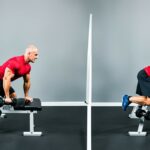Last Updated on 3 months by Francis
Reverse hyperextensions are a fantastic exercise for targeting the glutes and hamstrings. However, not everyone has access to a reverse hyperextension machine. But fret not! In this article, we will explore six alternative exercises that you can do at home to achieve the same benefits as reverse hyperextensions without the need for a machine.
Whether you’re looking to build strength, increase muscle activation, or prevent lower back injuries, these at-home reverse hyper exercises will help you reach your fitness goals without stepping foot in a gym.
Contents
Key Takeaways:
- Reverse hyperextensions are effective for developing the glutes and hamstrings.
- You can perform reverse hyperextensions at home without a machine using alternative exercises.
- Alternative exercises include reverse hyperextensions with a table, GHD machine, Nordic hamstring curls, Supermans, reverse hollow rocks, lying hamstring curls with towels, and reverse hyperextensions in a squat rack.
- These exercises offer various benefits such as muscle isolation, improved hip extension, and injury prevention.
- Proper form and set-up are essential for performing reverse hyperextensions effectively and safely.
Reverse Hyperextensions with Table
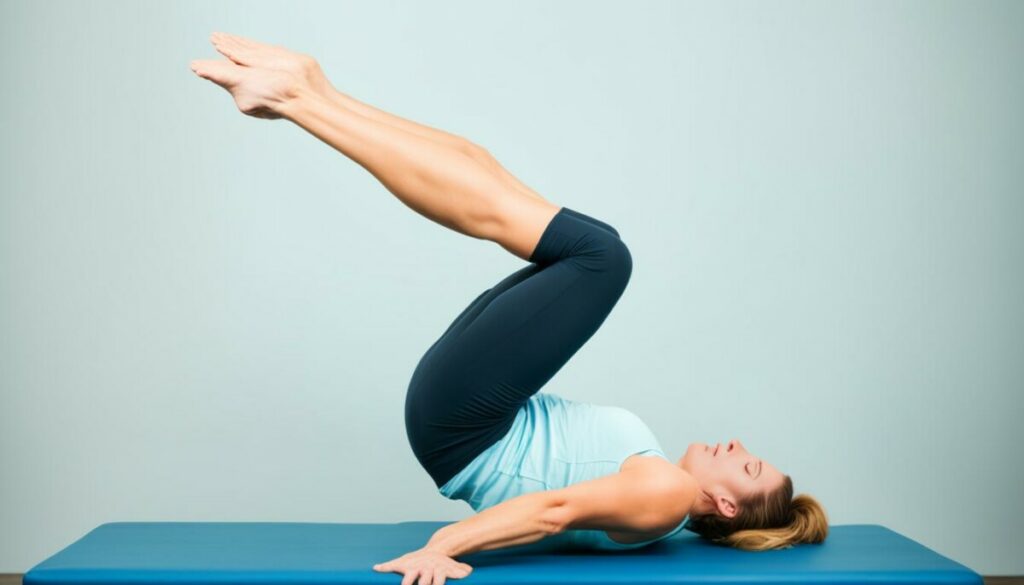
If you don’t have access to a reverse hyperextension machine, don’t worry. There’s an alternative that you can try at home – reverse hyperextensions with a table. This variation allows you to mimic the movement of reverse hyperextensions and target your glutes and hamstrings effectively.
Performing reverse hyperextensions with a table offers a greater range of motion compared to using a bench. It’s a simple and convenient option that can be done with readily available equipment in the comfort of your own home. However, it’s important to note that this exercise may lack some stability, so it’s crucial to exercise caution when performing it.
How to Perform Reverse Hyperextensions with a Table:
- Position a sturdy table horizontally behind you.
- Lie face down on the table, ensuring that your torso is resting comfortably on the surface.
- Engage your core and squeeze your glutes.
- Begin the movement by lifting your legs off the ground, extending them backward.
- Continue lifting until your legs are parallel to the ground or slightly higher, focusing on using your glutes and hamstrings to initiate the movement.
- Hold the position for a brief moment, then slowly lower your legs back down to the starting position.
- Repeat for the desired number of repetitions.
To increase the challenge of this exercise, you can add ankle weights or resistance bands to intensify the resistance. Remember to maintain proper form and control throughout the movement to ensure maximum effectiveness and minimize the risk of injury.
Reverse Hyperextension with GHD
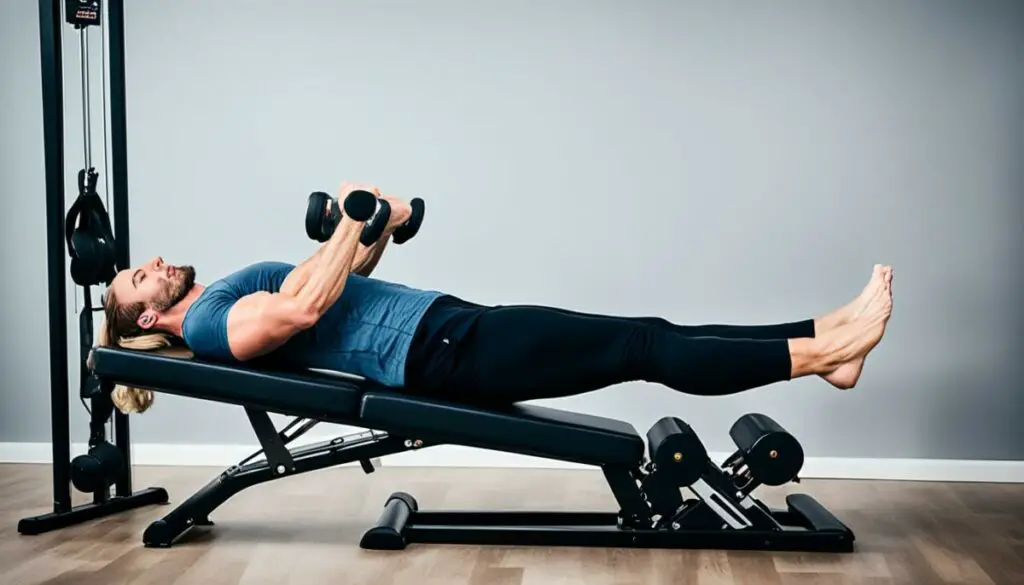
An additional alternative to reverse hyperextensions is utilizing a glute ham developer (GHD) machine. This exercise is effective in enhancing muscle endurance and activation in the glutes and hamstrings. While it may not offer the same loading capacity as a traditional reverse hyperextension machine, it provides a valuable option for a home workout routine.
Why Choose Reverse Hyperextension with GHD?
The reverse hyperextension with GHD offers several benefits:
- Activates the glutes and hamstrings
- Develops muscle endurance
- Improves hip extension
The exercise targets the glutes and hamstrings, facilitating increased strength, power, and overall fitness. It can be a valuable addition to any home workout routine.
How to Perform Reverse Hyperextension with GHD
Follow these steps to perform the reverse hyperextension with GHD:
- Position yourself face down on the GHD machine, with your hips resting on the pad and your feet securely positioned on the footplate.
- Make sure your knees are slightly bent and your core is engaged.
- Begin the movement by extending your hips and lifting your legs until they are parallel to the floor.
- Hold the top position briefly, engaging your glutes and hamstrings.
- Lower your legs back down under control to complete one rep.
- Repeat for the desired number of repetitions.
Remember to maintain proper form throughout the exercise, focusing on the mind-muscle connection with your glutes and hamstrings. Start with lighter weights or bodyweight and gradually increase the resistance as your strength improves.
Performing the reverse hyperextension with GHD can effectively target the glutes and hamstrings, helping you build muscle endurance and improve overall strength.
Nordic Hamstring Curls

If you’re looking to take your hamstring training to the next level, Nordic hamstring curls are a challenging and effective exercise. This advanced movement targets the hamstrings and forces maximal isometric and eccentric strength. By incorporating Nordic hamstring curls into your workout routine, you can optimize hamstring performance and improve overall lower body strength.
There are several variations of Nordic hamstring curls that can be performed depending on the equipment available to you. One option is to use a cable pulldown station, attaching the cable to a secure anchor point. Another option is to have a partner hold your feet down while you perform the movement. If you prefer, you can also position your feet under a barbell placed securely on a rack.
To execute the Nordic hamstring curl, begin by kneeling on a pad or mat with your knees hip-width apart. Engage your core and maintain a neutral spine throughout the exercise. Lower your upper body by slowly leaning forward, using your hamstrings to control the descent. Once you reach the end range of motion, use your hamstrings to pull yourself back up to the starting position.
Note: Nordic hamstring curls are an advanced exercise and may not be suitable for beginners or individuals with hamstring injuries. It’s important to use caution and start with a modified version of the exercise if necessary.
Benefits of Nordic Hamstring Curls
Nordic hamstring curls offer a range of benefits for athletes and fitness enthusiasts:
- Targeted hamstring development: Nordic hamstring curls specifically target the hamstring muscles, helping to build strength, power, and endurance in this area.
- Eccentric strength training: The eccentric phase of the exercise, during the lowering portion of the movement, places a high demand on the hamstrings, helping to develop eccentric strength.
- Injury prevention: Strengthening the hamstrings can help prevent hamstring strains and tears, which are common injuries in sports and physical activities.
- Increased athletic performance: Strong hamstrings contribute to improved performance in various sports and activities, including running, jumping, and change of direction movements.
By incorporating Nordic hamstring curls into your training routine, you can enhance hamstring strength and overall lower body performance.
Tips for Performing Nordic Hamstring Curls
Here are a few tips to keep in mind when performing Nordic hamstring curls:
- Start with a modified version: If you’re new to Nordic hamstring curls or have any concerns about your hamstring strength or flexibility, begin with a modified version. Instead of lowering your upper body all the way to the ground, only go partway down and gradually increase the range of motion as you build strength.
- Focus on control: The key to effective Nordic hamstring curls is maintaining control throughout the movement. Avoid using momentum to lift your upper body back up and instead rely on your hamstrings to control the ascent.
- Breathe properly: Remember to breathe throughout the exercise, inhaling as you lower your upper body and exhaling as you use your hamstrings to pull yourself back up.
- Take it slow: Nordic hamstring curls are a challenging exercise, so there’s no need to rush through the movement. Focus on maintaining proper form and pace yourself to ensure you’re getting the most out of each repetition.
With consistent practice and proper technique, Nordic hamstring curls can be a valuable addition to your hamstring training routine, helping you achieve optimal strength and performance.
Supermans
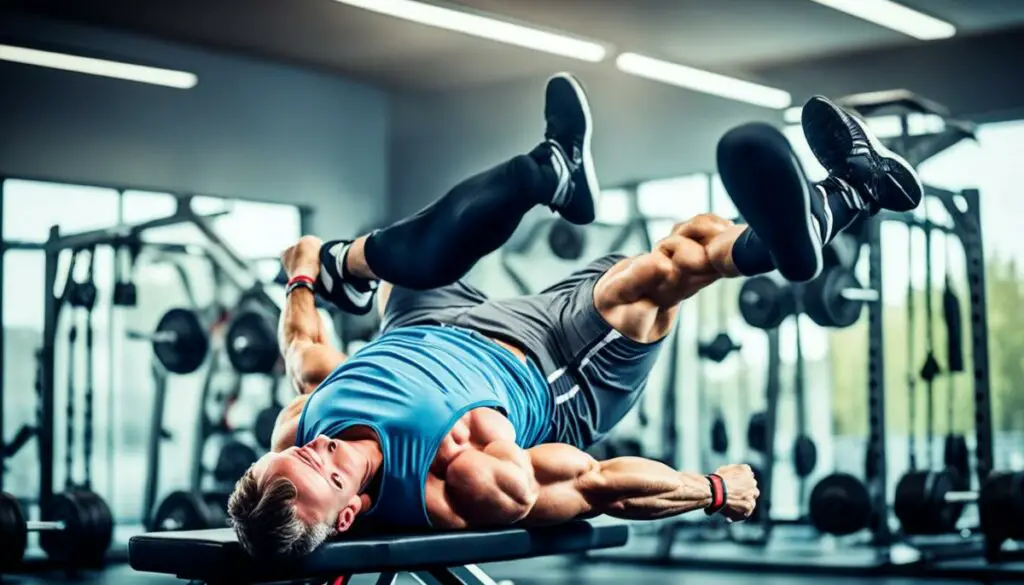
Supermans are a regress version of back extensions that strengthen the glutes and spinal erectors. This exercise is an excellent alternative to reverse hyperextensions as it requires no equipment and can be easily incorporated into your home workout routine. Supermans target the posterior chain, helping to improve overall strength and stability in the lower back and glute muscles.
To perform Supermans:
- Lie face down on a mat or comfortable surface.
- Extend your arms forward and your legs straight behind you.
- Engage your core and lift your arms and legs off the ground simultaneously.
- Hold this position for a few seconds, focusing on contracting your glutes and spinal erectors.
- Slowly lower your arms and legs back down to the starting position.
- Repeat for the desired number of repetitions.
To target the glutes even more during Supermans, you can perform the exercise with bent knees and actively point your toes downwards. This modification will increase the activation of your glute muscles and enhance the effectiveness of the exercise.
Supermans are a versatile exercise that can be incorporated into your home workout routine as a standalone exercise or as part of a full-body workout. They provide a great way to strengthen the posterior chain and improve overall stability in the lower back and glutes.
Benefits of Supermans
The benefits of including Supermans in your workout routine include:
- Strengthening the glutes and spinal erectors.
- Improving posture and spinal alignment.
- Enhancing core stability and balance.
- Increasing overall strength and endurance in the posterior chain.
By regularly incorporating Supermans into your home workout routine, you can enjoy these benefits and work towards achieving your fitness goals.
| Pros | Cons |
|---|---|
| Requires no equipment | May not provide the same level of resistance as a reverse hyperextension machine |
| Targets the glutes and spinal erectors effectively | May require additional modifications for more advanced athletes |
| Improves isometric control and stability | Does not offer as much range of motion as a reverse hyperextension |
Reverse Hollow Rocks
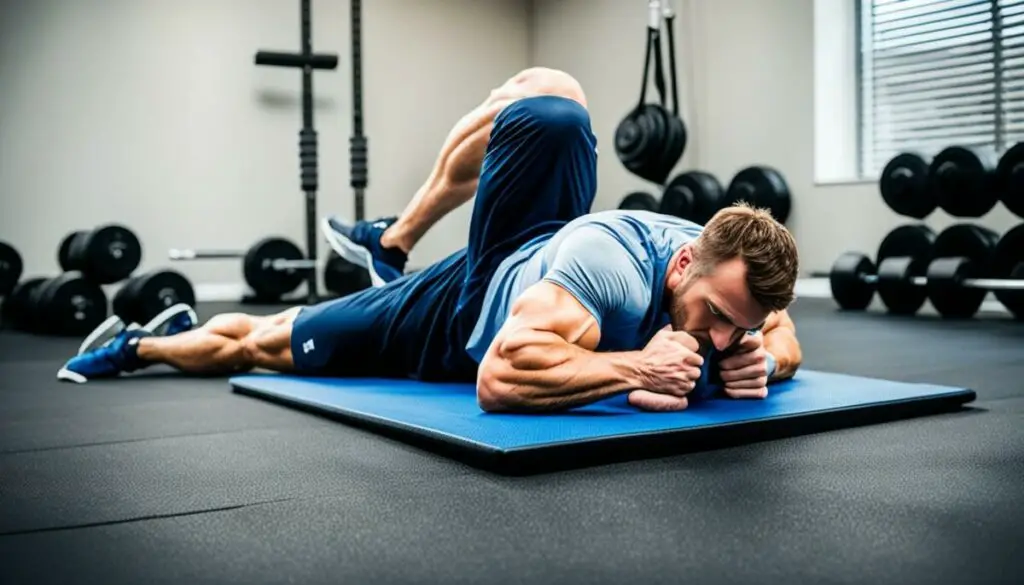
Reverse hollow rocks are a valuable variation of reverse hyperextensions that can be incorporated into your at-home workout routine. These isometric holds are designed to place the body in a hyperextended position, resulting in increased activation of the glutes and spinal extension.
While reverse hollow rocks may not offer the same range of motion as reverse hyperextensions, they are a versatile exercise that can be done by athletes of all fitness levels. Whether you are a beginner or an advanced athlete, reverse hollow rocks can help you strengthen your glutes and improve your spinal stability.
To perform reverse hollow rocks, follow these steps:
- Lie flat on your stomach with your arms extended overhead and your legs straight.
- Engage your glutes and lower back to lift your arms, chest, and legs off the ground.
- Hold the lifted position for a few seconds, focusing on maintaining a strong core and squeezing your glutes.
- Gently rock back and forth, using your core and glute muscles to control the movement.
- Continue rocking for the desired number of repetitions or time.
Reverse hollow rocks can be a challenging exercise, so it’s important to start with proper form and gradually increase the difficulty as you become more comfortable. Remember to breathe evenly throughout the movement and maintain control to avoid any excessive swaying or jerking.
Pro Tip: For an added challenge, you can place a small weight or resistance band around your ankles to increase the intensity of the exercise.
Incorporating reverse hollow rocks into your at-home workout routine can help you target your glutes and improve your spinal extension. By performing this exercise regularly, you can enhance your overall strength and stability, leading to improved athletic performance and better fitness outcomes.
Lying Hamstring Curls with Towels
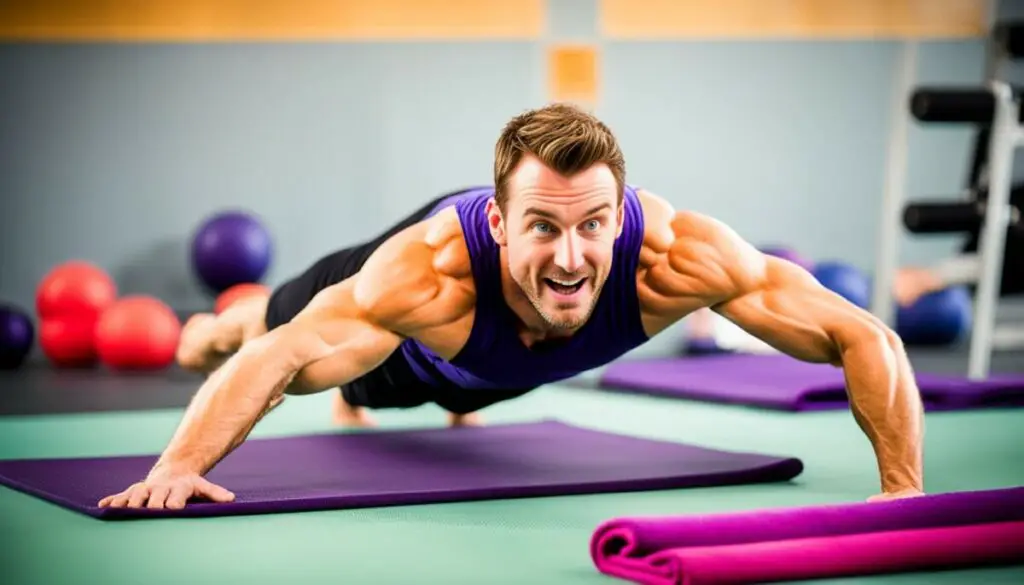
Looking for an alternative to reverse hyperextensions that you can do at home or in the gym without a machine? Lying hamstring curls with towels are a great option. This exercise targets the hamstrings and can be an excellent choice for coaches and athletes who want to improve their eccentric control and hamstring strength.
“Lying hamstring curls with towels are a simple yet effective exercise that can help strengthen and tone the hamstrings,” says fitness expert Jane Smith. “By using towels, you can create resistance and challenge the muscles in a controlled manner.”
To perform lying hamstring curls with towels, follow these steps:
- Start by lying flat on your stomach on a mat or the floor.
- Place a rolled-up towel under your ankles.
- Squeeze your hamstrings and glutes to raise your legs off the ground, bending at the knees.
- Hold the contraction for a second, then slowly lower your legs back down to the starting position.
- Repeat for the desired number of repetitions.
Tips for Proper Form
When performing lying hamstring curls with towels, keep the following tips in mind:
- Maintain a neutral spine throughout the exercise by engaging your core muscles.
- Focus on squeezing your hamstrings and glutes to perform the movement, rather than relying solely on momentum.
- Control the descent of your legs to maximize the eccentric contraction of the hamstrings.
- Start with a light towel or increase the resistance by using thicker towels or adding more layers.
Include lying hamstring curls with towels in your lower body workout routine to target and strengthen your hamstrings. Remember to always warm up properly before performing any exercise and consult with a qualified fitness professional if you have any underlying medical conditions or concerns.
| Exercise | Target Muscles | Equipment |
|---|---|---|
| Lying Hamstring Curls with Towels | Hamstrings, Glutes | Rolled-up Towels |
| Reverse Hyperextensions | Glutes, Hamstrings, Lower Back | Reverse Hyperextension Machine |
| Reverse Hollow Rocks | Glutes, Spinal Erectors | Bodyweight |
| Nordic Hamstring Curls | Hamstrings | Cable Pulldown Station or Barbell |
| Supermans | Glutes, Spinal Erectors | Bodyweight |
Reverse Hyperextension in a Squat Rack
Looking for unconventional ways to perform reverse hyperextensions at home? Consider using a squat rack! This alternative allows for greater loading of the hamstrings and glutes, providing a challenging workout comparable to using a reverse hyperextension machine.
However, before attempting this exercise, it is crucial to consider the stability of the barbell in the squat rack. Ensure that the rack is securely set up and can support the weight you’ll be using during the exercise. Safety should always be a top priority when working out.
By incorporating reverse hyperextensions in a squat rack into your home workout routine, you can effectively target your hamstrings and glutes, promoting strength and stability in these muscle groups.
Tips for Performing Reverse Hyperextensions in a Squat Rack
- Navigate the weight: Start with lighter weights and gradually increase the resistance to challenge your muscles without compromising form.
- Ensure proper form: Position yourself on the squat rack with the barbell resting on your lower legs above your ankles. Hold the barbell with a pronated grip, keeping your core engaged throughout the exercise.
- Control the movement: Lower your legs while maintaining a straight back and extend them until your body is in a straight line. Avoid swinging or using momentum to complete the exercise.
- Breathe correctly: Inhale during the eccentric, or lowering, phase and exhale during the concentric, or lifting, phase of the movement.
- Listen to your body: Pay attention to any discomfort or pain and adjust the weight and range of motion accordingly. If you experience any unusual sensations or persistent pain, consult a healthcare professional.
Lorem ipsum dolor sit amet, consectetur adipiscing elit. Vivamus justo nibh, aliquet a semper fringilla, condimentum in dolor. Etiam semper imperdiet elit, ac tempus nunc lobortis at. Nullam urna erat, sollicitudin eu tortor ut, ullamcorper iaculis urna. Ut suscipit purus sed lorem congue, in dictum ligula euismod. Curabitur ac iaculis purus. Sed sed lobortis lacus, in cursus lorem. Vestibulum efficitur massa in lobortis rutrum.
Lorem ipsum dolor sit amet, consectetur adipiscing elit. Vivamus justo nibh, aliquet a semper fringilla, condimentum in dolor.
| Exercise | Muscles Targeted | Equipment Needed |
|---|---|---|
| Reverse Hyperextension in a Squat Rack | Hamstrings, Glutes | Squat Rack, Barbell |
| Other Alternatives | Varies depending on the exercise | Varies depending on the exercise |
Benefits of Reverse Hyperextensions
Reverse hyperextensions offer several benefits that make them a valuable addition to your home workout routine. Whether you’re looking to strengthen your glutes, hamstrings, or lower back, incorporating reverse hyperextensions into your exercise regimen can provide numerous advantages:
1. Glute and Hamstring Isolation
Reverse hyperextensions specifically target the glutes and hamstrings, helping to isolate and strengthen these muscle groups. By focusing on these key areas, you can develop greater muscular control, endurance, and power in your lower body.
2. Improved Hip Extension
Performing reverse hyperextensions can lead to improved hip extension, making it easier to generate power and momentum in activities like running, jumping, and squatting. This enhanced range of motion can enhance your athletic performance and overall functional fitness.
3. Injury Prevention for the Lower Back
The reverse hyperextension exercise helps to strengthen the muscles in the lower back, reducing the risk of injury in this vulnerable area. By building up the muscles surrounding the spine, reverse hyperextensions can provide stability and support, allowing you to move with confidence and minimize the strain on your lower back.
Overall, reverse hyperextensions are an effective exercise for targeting key muscle groups, improving hip extension, and preventing lower back injuries. Whether you’re an athlete looking to enhance your performance or someone simply seeking to build strength and fitness at home, incorporating reverse hyperextensions into your workout routine can yield significant benefits.
Now that we’ve explored the benefits of reverse hyperextensions, let’s move on to the next section, which will provide a step-by-step guide on how to perform this exercise at home.
How to Do Reverse Hyperextensions
Reverse hyperextensions can be a highly effective exercise for strengthening the glutes and hamstrings. Whether you have access to a reverse hyperextension machine or are looking to perform this exercise at home, proper set-up and form are crucial for optimal results. Follow these tips to learn the proper technique for reverse hyperextensions and ensure a safe and effective workout:
Setting Up the Reverse Hyperextension Machine:
- Position yourself on the reverse hyperextension machine with your hips resting on the padded surface and your legs hanging off the edge.
- Secure your lower legs under the padded rollers or footrests, ensuring a comfortable and stable position.
- Adjust the machine’s settings according to your height and range of motion preferences.
Performing Reverse Hyperextensions with Home Equipment:
If you don’t have access to a reverse hyperextension machine, don’t worry! You can still perform reverse hyperextensions at home with alternative equipment:
- Table: Lie face down on a sturdy table with your hips positioned on the edge. Allow your legs to hang freely off the table’s edge. Use your arms to stabilize yourself by gripping the sides of the table.
- GHD Machine: If you have a glute ham developer (GHD) machine at home, you can utilize it for reverse hyperextensions. Follow the machine’s instructions for proper set-up and adjust the settings to your desired height and angle.
Proper Form for Reverse Hyperextensions:
“Maintaining proper form is essential to ensure the effectiveness and safety of reverse hyperextensions.”
Follow these guidelines to perform reverse hyperextensions with correct form:
- Engage your core: Before initiating the movement, activate your core muscles by drawing your belly button towards your spine.
- Focus on controlled movements: Lift your legs in a slow and controlled manner, using your glutes and hamstrings to raise them as high as possible.
- Avoid excessive back arching: While lifting your legs, be mindful of your lower back and avoid excessive arching. Maintain a neutral spine alignment.
- Pause at the top: Once your legs reach the highest point of the movement, hold the position briefly to maximize glute engagement.
- Lower with control: Lower your legs back down to the starting position in a slow and controlled manner, focusing on maintaining tension in the glutes and hamstrings.
Incorporate reverse hyperextensions into your lower body workout routine to strengthen your glutes and hamstrings effectively. Remember to start with lighter weights or bodyweight variations and gradually increase the resistance as you build strength and familiarity with the exercise.
| Benefits of Properly Executed Reverse Hyperextensions: |
|---|
| Targets the gluteal muscles and hamstrings for optimal strength and activation |
| Improves hip extension and increases overall lower body power |
| Aids in injury prevention by strengthening the lower back muscles |
By following the instructions provided and focusing on proper form, you can safely and effectively perform reverse hyperextensions at home. Whether you have a dedicated reverse hyperextension machine or utilize alternative equipment, incorporating this exercise into your routine will help you achieve greater strength and fitness in your glutes and hamstrings.
Reverse Hyperextension Variations
To keep your training routine varied and progressive, there are several different variations of reverse hyperextensions that you can incorporate. These variations target different aspects of glute and hamstring development, allowing you to tailor your workouts to your specific goals and needs.
Tempo Reverse Hyperextensions
One variation of reverse hyperextensions is performing them with tempo. By controlling the speed at which you perform the exercise, you can increase time under tension and challenge your muscles in different ways. For example, you can try a slower eccentric (lowering) phase or a pause at the top of the movement to maximize muscle engagement.
Banded Reverse Hyperextensions
Another variation is to add resistance bands to your reverse hyperextension exercises. This adds external resistance, increasing the intensity and difficulty of the movement. By selecting bands with different levels of tension, you can further customize the exercise to your strength level and progressively challenge your muscles over time.
Reverse Hyperextension Isometric Holds
Isometric holds can be an effective way to strengthen and target specific muscle groups. With reverse hyperextension isometric holds, you hold the top position of the exercise for an extended period of time. This helps to improve muscle endurance and develop greater stability in the glutes and hamstrings.
By incorporating these reverse hyperextension variations into your training routine, you can continue to challenge your muscles, avoid plateaus, and experience continued progress in your glute and hamstring development.
| Reverse Hyperextension Variation | Description |
|---|---|
| Tempo Reverse Hyperextensions | Perform reverse hyperextensions with varying tempos, such as a slower eccentric phase or a pause at the top of the movement. |
| Banded Reverse Hyperextensions | Add resistance bands to your reverse hyperextensions to increase intensity and challenge your muscles. |
| Reverse Hyperextension Isometric Holds | Hold the top position of the reverse hyperextension exercise for an extended period of time to improve muscle endurance and stability. |
Conclusion
Reverse hyperextensions are an invaluable exercise for strengthening the glutes, hamstrings, and lower back. However, not everyone has access to a reverse hyperextension machine at home. Fortunately, there are several alternatives that can be performed to achieve similar benefits without the need for special equipment.
By incorporating these reverse hyper extension exercises into your home workout routine, you can continue to work towards your fitness goals and improve overall strength and performance. Whether you choose to perform reverse hyperextensions with a table, utilize a glute ham developer (GHD) machine, or try other variations like Nordic hamstring curls, Supermans, reverse hollow rocks, lying hamstring curls with towels, or even perform reverse hyperextensions in a squat rack, there are plenty of options to keep your workouts challenging and effective.
No matter which alternative exercise you choose, it’s important to focus on proper form and technique. Ensure that you understand the set-up and execution of each exercise to maximize its benefits and minimize the risk of injury. Remember to start with lighter weights or easier variations and gradually increase the difficulty level as you become more comfortable and proficient in performing the exercises.
FAQ
Can reverse hyperextensions be done at home without a machine?
Yes, there are several alternatives to reverse hyperextensions that can be performed at home without the need for a machine.
How can I perform reverse hyperextensions using a table?
To perform reverse hyperextensions with a table, lie face down on the table with your hips at the edge. Hang your legs off the table and lift them upwards until your body forms a straight line. Lower your legs back down and repeat.
Is a glute ham developer (GHD) machine a good alternative for reverse hyperextensions at home?
Yes, a GHD machine can be used to perform reverse hyperextensions at home. However, it may not provide the same loading capacity as a traditional reverse hyperextension machine.
What are Nordic hamstring curls and how can I do them at home?
Nordic hamstring curls are an advanced exercise that targets the hamstrings. They can be done using a cable pulldown station or by placing the feet under a barbell or partner.
How do Supermans work and can I do them without any equipment?
Supermans are a variation of back extensions that strengthen the glutes and spinal erectors. They can be easily set up and executed without any equipment by lying face down on the floor and lifting the arms and legs off the ground simultaneously.
What are reverse hollow rocks and how do they target the glutes and spine?
Reverse hollow rocks are isometric holds that place the body in a hyperextended position. They increase glute activation and spinal extension, although they may lack the range of motion of reverse hyperextensions.
How can I do lying hamstring curls with towels at home?
Lying hamstring curls with towels can be done at home by lying face down on the floor with a towel under the feet. Bend the knees and pull the towel towards the glutes, contracting the hamstrings.
Can reverse hyperextensions be performed using a squat rack?
Yes, reverse hyperextensions can be done in a squat rack to allow for greater loading of the hamstrings and glutes. However, it is important to consider the stability of the barbell before attempting this exercise.
What are the benefits of performing reverse hyperextensions at home?
Reverse hyperextensions offer several benefits, including glute and hamstring isolation, improved hip extension, and injury prevention for the lower back. They target the hamstrings, glutes, and spinal erectors, leading to increased strength, power, and fitness in athletes.
How can I set up and perform reverse hyperextensions at home?
To perform reverse hyperextensions at home, you can use a table, a GHD machine, or other equipment. Proper set-up and form are crucial for performing this exercise effectively and safely. Instructions and tips will be provided in this section.
What are some variations of reverse hyperextensions that I can try?
There are several variations of reverse hyperextensions, including tempo reverse hyperextensions, banded reverse hyperextensions, and reverse hyperextension isometric holds. Each variation targets different aspects of glute and hamstring development.
Are there any recommended reverse hyper machines for home use?
There are several reverse hyper machines available for home use that are affordable and space-efficient. It is recommended to research and choose a machine that suits your specific needs and budget.
In conclusion, can I effectively perform reverse hyperextensions at home?
While a reverse hyperextension machine may not be accessible at home, there are several alternatives that can be used to achieve similar benefits. By incorporating these exercises into your home workout routine, you can continue to work towards fitness goals and improve overall strength and performance.


.jpg)


